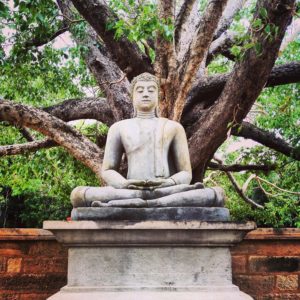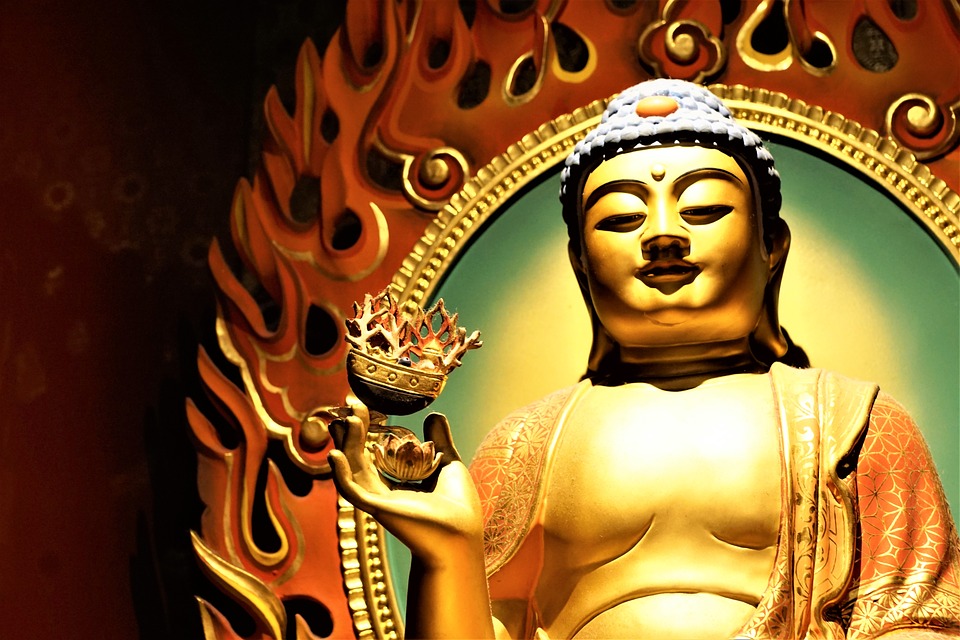In December 1999 the United Nations recognized Vesak as an internationally important day and twelve relics of the Buddha gathered from Myanmar, Thailand, and Sri Lanka were put on display at the UN Headquarters in New York under the sponsorship of the Supreme Patriarch of Thailand. Since then, they have been revealed in many cities across the USA and in Europe as part of around the world trip. On the weekend of the 1st of March 2003 for two days, they were shown for the first time in Switzerland at the International Conference Centre, Varambe at Geneva, the European home of the United Nations.
Hundreds gathered on Saturday and these numbers had swelled to almost unmanageable proportions by Sunday in the relatively small space allocated for the display, and the surrounding area. Even so, it was possible to view the relics, obtain food and refreshment and to listen to dignitaries and monks from many traditions without too much of a problem, including mini-conferences in the high tech, climate-controlled rooms of the building. The event was organized by the Venerable Walpola Kalyanatissa of the Swiss Buddhist Association and Ms. Ophelie Nilsvang, its President and the Master of Ceremonies.
 On Saturday, the relic casket was opened by Her Royal Highness, Princess Dala Sisouphanouvong from the former Laotian royal family. High ranking monks from all Buddhist traditions from Theravada to Tibetan incorporating Sri Lankan, Thai, Myanmar, Vietnamese, Chinese, Laotian sections were all represented including native speakers as well as speakers in French and English. Some of these monks lit a series of candles to mark the commencement of the proceedings. Ambassadors from Myanmar, Thailand, Sri Lanka, and Bhutan spoke in that order. The Myanmar ambassador stated that Buddhism was not strictly a religion and that the Buddhist tradition should be promulgated popularly. The Thai Ambassador stated that virtually all of the Thai population was Buddhist and that seven of the twelve relics on display were from Thailand. The Sri Lankan Ambassador mentioned that the recognition of the day of Vesak by the UN was initiated by Sri Lanka. He said that the spread of Buddhism and its decline from former hinterlands in Pakistan and Afghanistan had taken place peacefully and that “the righteous are protected by righteousness” quoting this in Pali. Religious representatives from other faiths including Christian, Lutheran, Islamic, Bhai and Vedantic Hinduism all spoke. The Vedantic representative stated that matter and mind tend to impinge on each other in subtle ways and that the relics would be giving off a special aura which would be of benefit. On Sunday, he quoted extensively from the Dhammapada (including Sanskrit) which won him a round of applause. There were small meetings, gatherings including interfaith dialog in conference rooms after lunch as well as chanting around the holy relics from the Theravada, Tibetan, and Vietnamese traditions, the latter with drumming and singing. Among the Tibetan chants was the Kab Sum Pa, chanted in Tibetan and in English translation. A Tibetan speaker thanked the organizers and Dhamma Kings of the past for having gathered and protected these relics to have enabled such an event to take place.
On Saturday, the relic casket was opened by Her Royal Highness, Princess Dala Sisouphanouvong from the former Laotian royal family. High ranking monks from all Buddhist traditions from Theravada to Tibetan incorporating Sri Lankan, Thai, Myanmar, Vietnamese, Chinese, Laotian sections were all represented including native speakers as well as speakers in French and English. Some of these monks lit a series of candles to mark the commencement of the proceedings. Ambassadors from Myanmar, Thailand, Sri Lanka, and Bhutan spoke in that order. The Myanmar ambassador stated that Buddhism was not strictly a religion and that the Buddhist tradition should be promulgated popularly. The Thai Ambassador stated that virtually all of the Thai population was Buddhist and that seven of the twelve relics on display were from Thailand. The Sri Lankan Ambassador mentioned that the recognition of the day of Vesak by the UN was initiated by Sri Lanka. He said that the spread of Buddhism and its decline from former hinterlands in Pakistan and Afghanistan had taken place peacefully and that “the righteous are protected by righteousness” quoting this in Pali. Religious representatives from other faiths including Christian, Lutheran, Islamic, Bhai and Vedantic Hinduism all spoke. The Vedantic representative stated that matter and mind tend to impinge on each other in subtle ways and that the relics would be giving off a special aura which would be of benefit. On Sunday, he quoted extensively from the Dhammapada (including Sanskrit) which won him a round of applause. There were small meetings, gatherings including interfaith dialog in conference rooms after lunch as well as chanting around the holy relics from the Theravada, Tibetan, and Vietnamese traditions, the latter with drumming and singing. Among the Tibetan chants was the Kab Sum Pa, chanted in Tibetan and in English translation. A Tibetan speaker thanked the organizers and Dhamma Kings of the past for having gathered and protected these relics to have enabled such an event to take place.
The crowds were best represented by Laotians and Vietnamese including an international audience in smaller numbers. When the relics were brought into the Conference Center, the crowds lined the way and spontaneously knelt down as they got closer, with the head bowed and hands together, many not even daring to look at the relics. Cameras and heads craned to see the relics and rules prohibiting photography of the relics themselves were compromised. Bundles of orchids with candles and incense were laid on the relic platform which also included several statues of the Buddha, placed to receive the power of the chants and the relics by their owners. It was a moving experience to see how people entering the hall related to the relics in a manner redolent of the display of a cortege of a beloved national figurehead. Most individuals bowed and prostrated repeatedly including Europeans and there was much excitable and emotional chanting, especially among the Vietnamese crowds.
Where are the relics?
The relics were housed in a large, golden stupa of Thai style though they were kept outside this for the duration of the ceremony. The relics themselves were kept in a soft material in a small circular container measuring no more than 2.5cm. This was rested on a tiered tray surrounded by gems and covered over with a transparent glass dome which in turn was symbolically protected by a tiered golden umbrella. These stood on a large platform arranged with flowers. Flowers from devotees had to be periodically moved away to make room for new offerings.
The largest of the relics was about 1cm long and they were of different shapes including two pearly spheres. They were cream-colored, somewhat smooth and sometimes shiny including small elongate structures. Undisputed relics of the Buddha discovered in 1897 were passed over to the then king of Thailand Chulalankara by the British though it was not clear if the relics on display included some of these.
One Tibetan speaker stated that it was not too important if the relics were genuine mentioning a story of a Chinese woman desperate for a relic from his son who regularly visited India. He eventually, having forgotten presented her with a dog’s tooth, which enabled her in her heightened faith to win Enlightenment. A Zen monk told me that he was a minority here as Zen practitioners did not take relics seriously. He did mention in this connection that Niels Bohr, the Danish quantum physicist had once converted his barn into a workshop with a horseshoe over the door which he placed himself. His friends asked him whether he believed in it. He replied that he didn’t “but people say it works even if you don’t believe in it!”
Venerable Maha Lao and Dr. Rewata Dhamma were present from Birmingham and among the morning speakers on Sunday was a politically minded Sri Lankan monk who warned “Buddhists” against Islam and fundamentalism in the light of wars against terrorism now in the news. As if in response, Lama Gangchen from Italy repeated through a translator thrice that “Inner peace is the foundation for outer peace”. Lama Gangchen looks forward to receiving the relics for a further public display in Italy.
Buddha’s presence through the relics
The whole event was a moving, sometimes emotional spectacle that was well organized. The power of the Buddha’s presence through the relics seemed strong on the bright spring day of Saturday and the word had evidently got round so that by Sunday the crowd was thicker. What I found impressive was the spontaneous responses of devotion from people who were encountering the relics for the first time including many who were not Buddhist. Such expression was a connection between the inner self and the historical Buddha representing peace and transcendence through his gathered bones from around two and a half millennia ago.
The relics of the Buddha may be seen at two or three places in the UK including three microscopic pearls at the Samatha Centre, Greenstreet in Llangunllo, Powys, Wales.





